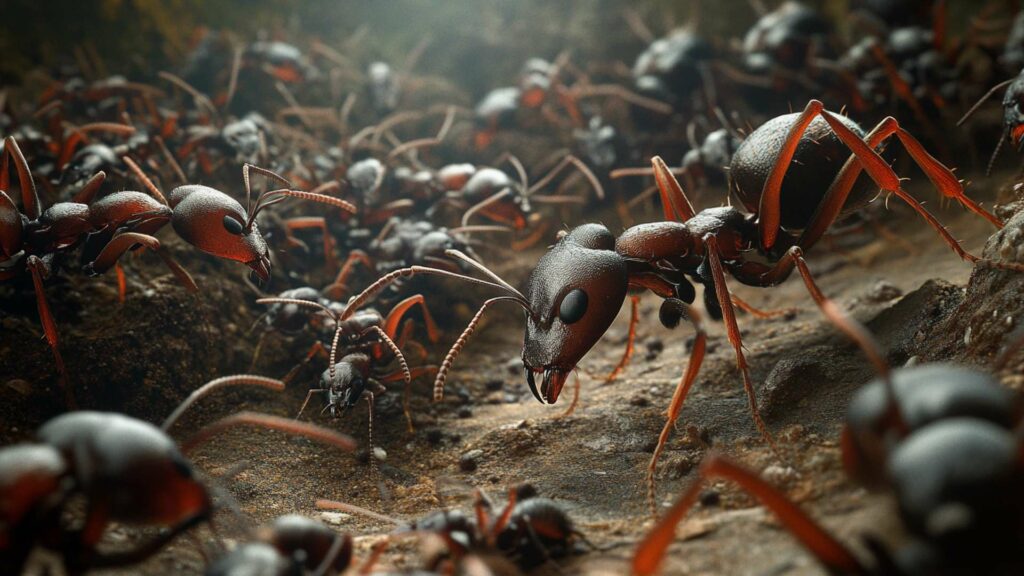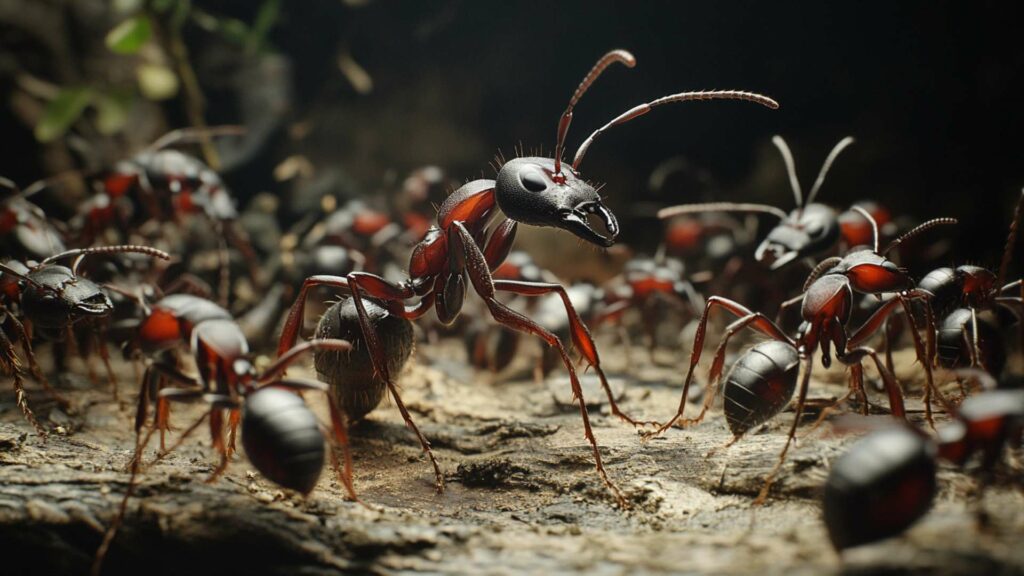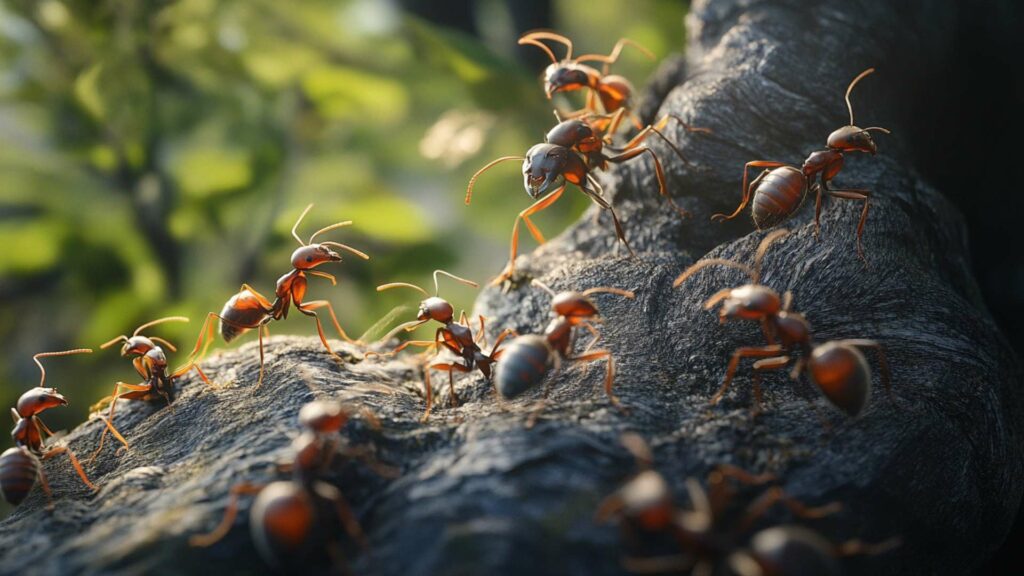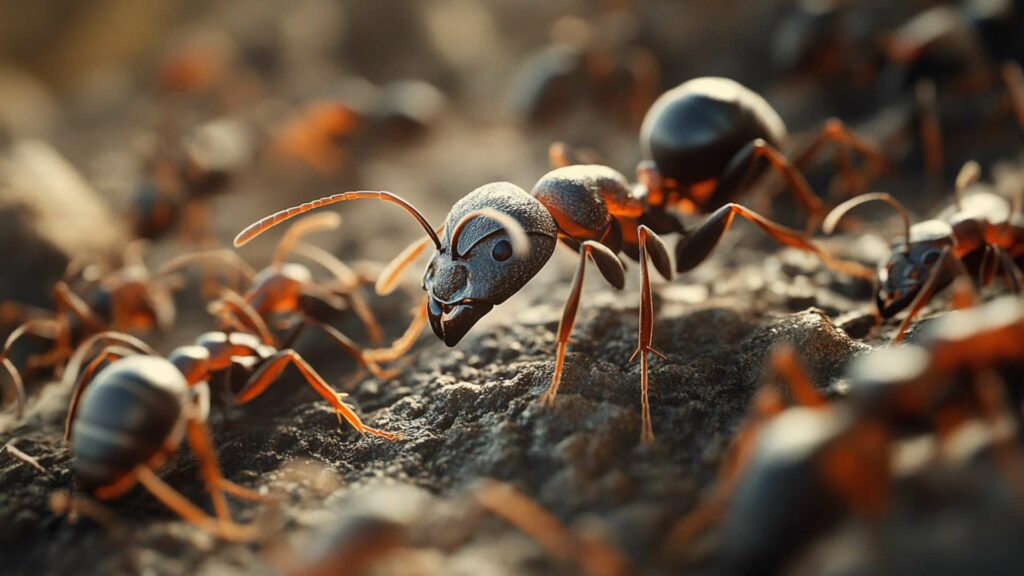Ant hills, those small mounds of earth that seem to pop up overnight in our backyards and gardens, are not just innocent piles of dirt. They are the result of complex behaviors within an ant colony, and can quickly become a nuisance for many homeowners.
These tiny hills may seem harmless at first glance, but their presence often indicates a thriving ant colony nearby. So, what exactly are ant hills?
Well, they are essentially the visible evidence of an underground world teeming with activity. Ants create these mounds as a byproduct of constructing their nests beneath the ground.
They excavate soil from tunnels and chambers below, carrying it to the surface and depositing it in neat piles. The size and shape of an ant hill can vary depending on the species of ants inhabiting it, but they typically consist of loose soil held together by secretions from the ants themselves.
While ant hills may appear harmless to some, they can actually pose several problems for homeowners. First and foremost is the aesthetic factor – nobody wants unsightly mounds littering their perfectly manicured lawn or garden bed.
Additionally, these anthills can damage lawnmowers or other yard maintenance equipment if accidentally run over. Furthermore, certain species most ants like Argentine ants or fire ants are aggressive and have painful bites or stings that can be a real threat to you or your pets.
To add insult to injury, ant hills often serve as a hub for other ants too! These pesky invaders find abandoned anthills an ideal location for establishing their colonies as well.
Therefore, if many ant hills are left unchecked, what starts as a single anthill could quickly turn into multiple colonies spreading across your yard. In this article, we will explore various effective methods to get rid of ant hills once and for all.
From natural remedies using household items to advanced techniques involving professional products – we’ve got you covered! But before we delve into the nitty-gritty of ant hill elimination, let’s first understand the behavior and biology of these industrious insects.
Understanding Ant Behavior

The Intricate World of Ant Colonies
Ant colonies are bustling societies, teeming with industrious workers, soldiers fiercely protecting their queen and a complex division of labor. These extraordinary creatures have perfected the art of cooperation and coordination, allowing them to thrive in various environments.
Within ant colonies, there exists a clear hierarchical structure where every ant has a defined role. At the top of the pyramid sits the queen, who is responsible for reproduction and ensuring the survival of the entire colony below.
She resides comfortably deep within the cozy chambers of the ant mound, laying thousands of eggs to perpetuate her lineage. Surrounding her are diligent worker ants – females who carry out numerous tasks essential to colony maintenance such as foraging for food, building nests, and caring for larvae.
The Artistry Behind Ant Hills

Ant hills – those miniature mounds that dot our lawns and gardens – are marvels of engineering created by thousands of tiny architects working in harmony. The process begins with worker ants excavating soil from beneath the ground to form intricate tunnels that serve as underground highways connecting various chambers within their realm.
As these diligent workers continue their excavation efforts, they bring soil particles up to the surface using an ingenious method known as “tossing.” They push soil grains up through interconnected tunnels until it reaches the top and cascades down outside in a neat mound-like structure. This enables them to create ventilation shafts while simultaneously expanding their living space.
To maintain stability and protect against elements like rainwater erosion or predators’ attempts at infiltration, some ant species construct elaborate architectural features around their mounds. These could include intricate patterns made from pine needles or small pebbles that provide structural reinforcement while enhancing defense capabilities.
Understanding this fascinating behavior helps us appreciate both the complexity and necessity of ant hills within an ecosystem. However, when these mounds become unwanted intruders in our backyard or garden, it becomes crucial to learn how to get rid of ant hills effectively and safely.
Identifying Ant Hills
Description of typical appearance and characteristics of ant hills
Ant hills are fascinating structures created by industrious ants in their quest for survival. These mounds, often made from tiny soil particles, can vary in size and shape depending on the species of ant.
They are usually conical or dome-shaped, with entrances located at the top or on the sides. Some ant hills may be small and inconspicuous, while others can reach impressive heights.
The appearance of ant hills also depends on the type of ant constructing them. For instance, red ants tend to build reddish-brown mounds that stand out against the grassy backdrop, making them easier to spot.
On the other hand, argentine ants construct low-profile mounds that blend seamlessly into their surroundings. Additionally, some ants incorporate organic matter like leaves or twigs into their hill structures, adding complexity to their appearance.
Tips for locating ant hills in your yard or garden
Locating ant hills in your yard or garden is crucial to effectively combatting these persistent pests. Here are some handy tips to help you pinpoint their elusive abodes:
1. Scout for worker ants: Keep a close eye on any trails of worker ants marching back and forth; they are likely heading towards an active nest nearby.
2. Look for disturbed soil: Ants tend to excavate large volumes of soil when constructing their nests underground. Inspect areas where you notice a small mound, piles, or depressions in your yard’s surface.
3. Observe grass behavior: If you spot patches of grass that appear unusually healthy or discolored compared to surrounding areas, it could be an indication of an underlying ant nest disrupting root systems.
4. Use sugar-based baits: Set out sugar-based baits like honey or syrup at various spots in your yard and observe which locations attract a higher number of ants. This can lead you closer to the source – their ant hill. Remember, ants tend to nest in warm and moist areas, so pay particular attention to places near water sources, such as sprinklers or leaky pipes.
By combining these tactics, you can successfully locate the troublesome ant hills and take action to address the issue. Stay tuned for the upcoming sections to learn effective techniques for getting rid of ant hills permanently and safely in your yard or garden.
Natural Methods to Eliminate Ant Hills
Pouring boiling water into the hill to kill the ants

Ant hills can be quite a nuisance, especially when they start popping up all over your beautiful garden or lawn. One natural and effective way to tackle this problem is by using boiling water. The theory behind this method is simple: the extreme heat of the water destroys all the oxygen in ants’ exoskeletons, effectively killing them.
When you pour boiling water into an ant hill, it penetrates deep into their nest, reaching the queen and her army of worker ants. When using this method, it’s crucial to exercise caution and follow safety precautions.
Boiling water is hot and can cause injury if not handled properly. Wear protective gloves and use a kettle or pot with a spout for controlled pouring.
Slowly pour the boiling water over and around the ant hill, aiming for its center as much as possible. Be careful not to splash yourself or others nearby with hot water.
Sprinkling food-grade diatomaceous earth around the hill

Another natural solution for getting rid of ant hills involves using food-grade diatomaceous earth (DE). DE is derived from fossilized algae called diatoms that have sharp microscopic edges, which are harmless to humans but lethal to insects like ants.
Sprinkling a thin layer of DE around an anthill creates a barrier that cuts through an ant’s exoskeleton as it crawls over it, leading to dehydration and eventual death. To apply diatomaceous earth effectively in your battle against ant hills, ensure you’re using food-grade DE rather than pool-grade DE, which contains harmful additives.
Start by identifying active anthills in any bare spots of your garden or lawn. With gloves on hand (to avoid skin irritation), sprinkle a liberal amount of DE near the entrance of each mound while attempting not to disturb it too much.
It’s crucial to reapply DE after rain or heavy watering, as it can lose its effectiveness when wet. Remember, safety comes first when using any natural method.
Avoid inhaling diatomaceous earth by wearing a mask during application and keep children and pets away from treated areas until the dust has settled. By employing these natural methods, you can effectively eliminate ant hills in your garden without resorting to harmful chemicals or pesticides.
Homemade Remedies for Ant Hill Removal
Creating a vinegar solution to deter ants from building hills

Ants can be pesky little creatures, constantly building their mounds in our outdoor areas and wreaking havoc on our gardens. Luckily, there are some effective homemade remedies you can try to get rid of the infestation of these unwelcome guests.
One such remedy is a vinegar solution. Vinegar has long been known for its ability to repel ants due to its strong smell and acidity.
To create this solution, simply mix equal parts of water and white vinegar in a spray bottle. Shake well and generously spray the mixture around areas where you’ve noticed ant activity or where you want to prevent them from building hills.
The effectiveness of the vinegar solution lies in its odor, which ants find offensive and unpleasant. As they rely heavily on their sense of smell for communication and navigation, the strong scent of vinegar disrupts their trails, making it difficult for them to find their way back to the nest or establish new colonies nearby.
Remember, ants are highly sensitive creatures that operate on chemical cues, so this natural deterrent can work wonders in deterring them from your outdoor spaces. For even better results against those persistent little critters, consider combining other household items with vinegar.
For instance, adding a few drops of essential oils such as peppermint or tea tree oil can enhance the repellent properties of your solution. These oils have proven antifungal and insecticidal qualities that not only help drive away ants but also leave your outdoor area smelling fresh and aromatic.
Using a mixture of dish soap and water as an ant-killer spray
Another effective homemade remedy for taking care of ant hills is using a simple mixture of dish soap and water as an ant killer spray. The soapy water disrupts the waxy outer layer of an ant’s exoskeleton, causing it to lose moisture rapidly, leading to dehydration and ultimately death.
To make this solution, mix a few tablespoons of dish soap with water in a spray bottle. Shake gently until it is well combined.
When applying the solution, it’s important to target the ant hills directly. Spray the mixture generously over the ant mounds, ensuring that each one or large mound is thoroughly covered.
The soap will penetrate the tunnels and galleries within the mound, reaching the heart of their nest. Be sure to repeat this process daily for several days until you notice a significant reduction in ant activity.
To maximize effectiveness, consider using warm or hot water instead of cold water when preparing your soapy mixture. The higher temperature helps dissolve the protective wax layer on an ant’s exoskeleton more quickly and therefore increases its vulnerability.
In addition, using a sprayer with good pressure will help you reach those deeper underground nests where ants may have built extensive tunnels. Now armed with these simple homemade remedies such as vinegar solutions and soapy sprays, you can bid farewell to those irritating ant hills in your garden or lawn without resorting to harmful chemicals or expensive treatments.
Biological Control Methods for Ant Hill Eradication
Introducing beneficial nematodes into the soil
When it comes to combating ant hills in your outdoor area, nature provides us with some remarkable allies – beneficial nematodes.
These microscopic worms are natural predators of ants and can be a powerful weapon in your quest to eliminate those pesky ant hills. Beneficial nematodes are readily available for purchase at garden centers or online, making them an accessible option for ant control.
Description of nematodes’ ability to prey on ant larvae
Beneficial nematodes play a significant role in controlling ant populations by targeting the most vulnerable stage of their life cycle – the larvae.
Once applied to the soil, these minuscule warriors actively seek out ant larvae, penetrating their bodies and releasing bacteria that quickly kill them. It’s like sending an invisible army into the soil to dismantle and destroy the very foundation of the ant hill, interrupting their life cycle and preventing new colonies from forming.
Guidelines on purchasing, storing, and applying nematodes

To effectively utilize beneficial nematodes against ant hills, follow these guidelines when purchasing, storing, and applying them:
1. Purchase fresh nematodes: Look for reputable suppliers who offer high-quality, viable nematode strains specifically designed for controlling ants.
2. Proper storage conditions: Keep your beneficial nematodes refrigerated until ready for use but avoid freezing them as extreme temperatures can harm their effectiveness.
3. Application method: Mix the recommended amount of nematode solution with water according to package instructions. Use a garden sprayer or a regular garden hose attachment to evenly distribute the solution across infested areas. Make sure you apply the nematodes during cool, cloudy days to increase their survival rate.
4. Repeat applications: For long-lasting pest control, repeat nematode applications every few months or as recommended by the supplier. This ensures that any surviving ants or newly hatched larvae will be targeted, resulting in a more thorough eradication.
Planting

Another effective biological approach to keeping ant hills at bay is through strategic landscaping. By selecting plants that naturally repel ants, you can discourage them from establishing colonies near your outdoor area.
Some plants known for their ant-deterring properties include lavender, mint, catnip, and marigolds. Planting these fragrant herbs and flowers strategically around your yard not only adds beauty but also acts as a natural barrier against ant invasions.
Additionally, consider removing excess mulch or debris near structures where ants tend to build nests. By minimizing potential hiding spots and providing less desirable conditions for establishing colonies, you can make your outdoor space less inviting to these tiny intruders.
Conclusion
In the battle against ant infestation hills, biological control methods offer a sustainable and eco-friendly way to get rid of ants without resorting to harmful chemicals. Beneficial nematodes act as nature’s tiny warriors by targeting the vulnerable larvae stage of ants’ life cycle, effectively dismantling their colonies from within. Combined with strategic planting of ant-repellent herbs and flowers, you can create an environment that discourages ant infestations altogether.
By embracing these natural solutions and taking proactive measures in your outdoor area, you can enjoy a peaceful garden free from the annoyance caused by those persistent ant hills. So go ahead and unleash nature’s predators into your soil while transforming your landscape into an anti-ant fortress – it’s time to reclaim your territory with Mother Nature on your side!
Dissuade Ants with D-Termination: The Top Pest Control Choice in Las Vegas!

If you’re grappling with ant problems, turn to D-Termination for help. Our skilled team excels at discouraging ants, revitalizing cleanliness, and preserving the integrity of your area. Bid farewell to ants—opt for D-Termination for highly effective pest control today!
Contact us at 702-919-6310 or visit dtermination.com to schedule your ant control service and regain your space from these unwelcome pests.
Frequently Asked Questions:
To permanently eliminate an ant hill, use an ant bait or contact a pest control professional.
Natural methods like pouring boiling water or diatomaceous earth can help eradicate ant hills, but long-term results may vary.
Destroying ant hills can disrupt ant colonies, but it’s often necessary to prevent infestations.
Vinegar may kill some ants, but it’s not the most effective method for eliminating an entire ant hill.








